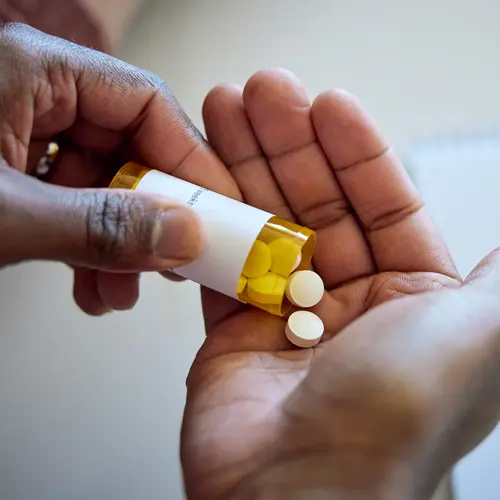Neuroleptic malignant syndrome (NMS) is a rare reaction to antipsychotic drugs that are used to treat schizophrenia, bipolar disorder, and other mental health conditions. It affects the nervous system and causes symptoms such as a high fever and muscle stiffness.
The condition is serious but treatable. Most people who get it make a full recovery if it’s found early.
Neuroleptic Malignant Syndrome Causes
NMS is very rare. Only about 1 to 2 out of every 10,000 people who take antipsychotic drugs get it. All antipsychotic drugs can cause NMS.
The older antipsychotic drugs include:
- Chlorpromazine (Thorazine)
- Fluphenazine (Prolixin)
- Haloperidol (Haldol)
- Loxapine (Loxitane)
- Perphenazine (Etrafon)
- Thioridazine (Mellaril)
Doctors call the newer antipsychotic drugs "atypical antipsychotics." They include:
- Aripiprazole (Abilify)
- Asenapine (Saphris)
- Brexpiprazole (Rexulti)
- Cariprazine (Vraylar)
- Clozapine (Clozaril)
- Iloperidone (Fanapt)
- Olanzapine (Zyprexa)
- Paliperidone (Invega)
- Quetiapine (Seroquel)
- Risperidone (Risperdal)
- Ziprasidone (Geodon)
These drugs block a brain chemical called dopamine. That can lead to muscle stiffness and rigid movements, particularly in people with Parkinson's disease.
Any antipsychotic drug can cause NMS. But stronger drugs, such as fluphenazine and haloperidol, are more likely to trigger it.
NMS is more common in men than in women. You're also more likely to get it if you:
- Take a high dose of the drug
- Quickly increase your dose
- Get the medicine as a shot
- Switch from one antipsychotic drug to another
Some drugs used to treat nausea and vomiting can also cause NMS because they block dopamine. These include:
- Domperidone (Motilium)
- Droperidol (Inapsine)
- Metoclopramide (Reglan)
- Prochlorperazine (Compazine)
- Promethazine (Phenergan)
People who take drugs for Parkinson's disease, such as levodopa, can get NMS if they stop taking their medicine too quickly.
Neuroleptic Malignant Syndrome Symptoms
NMS symptoms often start within 2 weeks of starting the medicine or changing your dosage. Sometimes, they show up a few days after you start to take the medicine. Or you might not have any symptoms until months later.
NMS symptoms usually last 7-10 days. They may include:
- High fever (102-104 F)
- Muscle stiffness
- Sweating a lot
- Anxiety or other changes in mental state
- Fast or abnormal heartbeat
- Quick breathing
- More saliva than usual
NMS can damage muscles and cause very high or low blood pressure. If you’re not treated quickly, you can get serious problems, such as:
Neuroleptic Malignant Syndrome Diagnosis
Your doctor will ask about the medicines you take and look for the main symptoms of NMS — a high temperature, stiff muscles, and an altered mental state. To meet the full criteria for diagnosis, you also need to have at least a couple of other warning signs, such as a fast heartbeat, low or high blood pressure, and sweating.
Some other disorders have symptoms that are similar to those of NMS. To figure out if you have it, your doctor will do one or more of these tests:
- Blood and urine tests
- Brain imaging scans
- Spinal fluid test
- Electroencephalogram (EEG) to find electrical problems in the brain
Neuroleptic malignant syndrome vs. serotonin syndrome
Another rare condition caused by medications used for mental health conditions is serotonin syndrome. It's caused by medications that change levels of serotonin, a chemical messenger produced by nerve cells in your brain and elsewhere in your body. These medications include many antidepressants and the mood stabilizer lithium.
Like NMS, serotonin syndrome can cause rigid muscles and high fever, but its symptoms are usually less severe. Serotonin syndrome also has some distinct symptoms, such as muscle spasms, tremors, diarrhea, and nausea, which can help your doctor tell the two conditions apart. Lab tests can help confirm the right diagnosis if, for example, you are taking multiple drugs that could cause either or both problems.
Neuroleptic malignant syndrome vs. malignant hyperthermia
Another rare condition, malignant hyperthermia, can cause very high fevers, rigid muscles, slow reflexes, and skin changes. This happens usually after someone gets general anesthesia or takes muscle relaxants. Your doctor can usually tell these two conditions apart, based on the medications you've taken.
Neuroleptic Malignant Syndrome Treatment
Expect your doctor to treat NMS as a medical emergency. They may start treatment immediately to lower the risks of complications such as kidney failure, seizures, and blood clots.
Your doctor will first take you off the drug that caused this syndrome. Often, people with NMS get treatment in a hospital intensive care unit. The goal is to bring down your fever and give you fluids and nutrition. You might also get medications, which may include:
- Drugs that relax tight muscles, such as dantrolene (Dantrium)
- Parkinson's disease drugs that make your body produce more dopamine, such as amantadine (Symmetrel) or bromocriptine (Parlodel)
If these medicines don't help, your doctor might try electroconvulsive therapy. It's a pain-free treatment during which you remain asleep. A small electric current travels through your brain to trigger a seizure. This won’t hurt you, and it should ease your symptoms.
NMS usually gets better in 1-2 weeks. After recovery, most people can start taking antipsychotic medicine again. Your doctor might switch you to a different drug.
NMS can come back after you’re treated. Your doctor will closely check for any signs of it. The longer you wait to go back on antipsychotic drugs, the less likely you'll be to get NMS again.
Takeaways
Neuroleptic malignant syndrome is a rare condition that might show up if you take antipsychotic drugs for schizophrenia, bipolar disorder, or another condition. If you notice sudden symptoms such as muscle stiffness and unexplained fever, get medical help right away because delays in treatment can harm you. With prompt care, most people recover completely.

